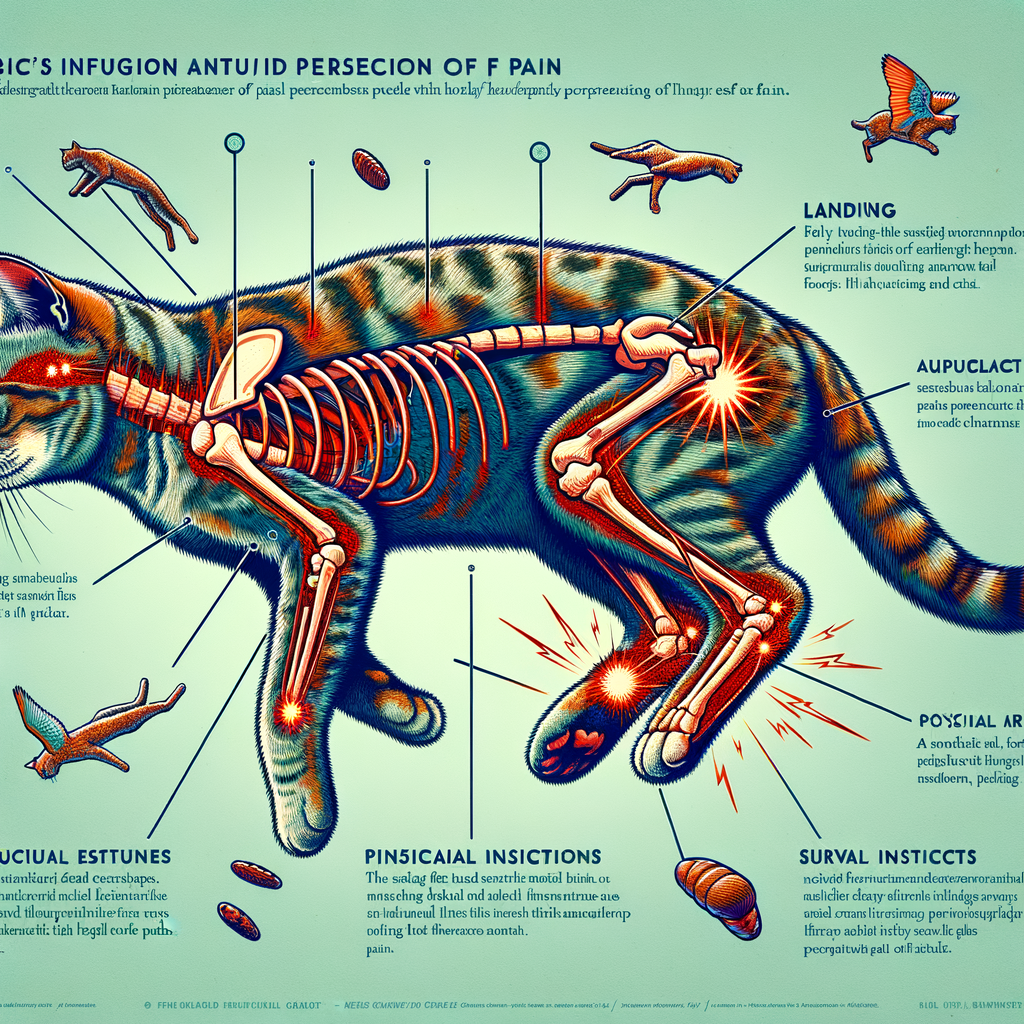
Introduction: Do Cats Feel Pain After a Fall?
Have you ever wondered if your furry friend feels pain after a fall? This is a question that has puzzled many cat owners. In this article, we will explore this topic in detail.
- Overview of the topic
- Importance of understanding feline pain perception
Cats are known for their agility and ability to land on their feet after a fall. This is due to a unique mechanism in their body known as the ‘righting reflex’. However, this doesn’t mean they are immune to pain or injury. The impact of a fall can vary depending on several factors such as the height of the fall, the cat’s health, age, and body condition.
Understanding how cats perceive pain is crucial for their well-being. Cats are experts at hiding their pain, a behavior inherited from their wild ancestors to avoid appearing weak to predators. Therefore, it’s important for cat owners to be observant and know the signs of pain in cats. Recognizing pain early can help in providing timely medical attention and prevent further complications.
Stay with us as we delve deeper into understanding the cat’s landing mechanism and how it affects their perception of pain after a fall.
Understanding the Cat’s Landing Mechanism
Have you ever wondered how cats always seem to land on their feet, no matter how they fall? This isn’t just a random occurrence, but a result of their unique skeletal structure and an evolutionary advantage that has helped them survive in the wild. Let’s delve into the details.
Cats Landing on Feet: An Evolutionary Advantage
It’s quite fascinating how cats have this extraordinary ability to land on their feet. This is not just a mere coincidence, but a result of millions of years of evolution. Let’s explore how their unique skeletal structure plays a crucial role in this.
- Explanation of the cat’s unique skeletal structure
- How this structure aids in landing
Cats have a skeletal structure that is quite different from most other animals. They have a flexible backbone and a clavicle, or collarbone, that is free-floating. This means it is not connected to other bones but held in place by muscles. This unique structure allows them to twist and turn their bodies in ways that other animals cannot.
When a cat falls, it instinctively twists its body in the air to face downwards. The flexible backbone allows it to do this quickly and efficiently. The free-floating clavicle gives the front legs a wide range of motion, enabling the cat to extend them outwards to absorb the shock of landing. This is how cats manage to land on their feet almost every time they fall.
In conclusion, the ability of cats to always land on their feet is a remarkable evolutionary advantage. It’s a testament to the wonders of nature and the intricate design of the feline skeletal structure. So, next time you see a cat land on its feet, remember, it’s not just luck, but a complex mechanism at work.
Physics Behind Cats Falling from Heights
- Explanation of terminal velocity in cats: Terminal velocity is the fastest speed a falling object can reach. For cats, this is surprisingly low – around 60 mph. This is because they spread their bodies out like a parachute, slowing their fall.
- How cats adjust their bodies during a fall: Cats have a unique ability to twist their bodies in mid-air. This is called the ‘righting reflex’ and it helps them land on their feet. They also spread their legs out to slow their fall and absorb the impact.
- Visible signs of pain in cats: Cats are good at hiding their pain, but there are some signs you can look for. These include limping, loss of appetite, and changes in behavior. If your cat shows any of these signs after a fall, it’s important to get them checked by a vet.
- How cats hide their pain: an evolutionary perspective: In the wild, showing pain can make an animal a target for predators. That’s why cats have evolved to hide their pain. But this can make it harder for us to know when they’re hurt.
- Review of key studies on feline pain perception: Studies have shown that cats do feel pain, just like humans. But they may experience it differently. For example, they might not show any signs of pain even when they’re seriously injured.
- How these studies inform our understanding of cats’ pain after falling: These studies help us understand that just because a cat lands on its feet, doesn’t mean it’s not hurt. Even a small fall can cause serious injuries.
- Types of injuries cats can sustain from falls: Cats can suffer from broken bones, internal injuries, and even brain damage from falls. The higher the fall, the more serious the injuries can be.
- Case studies of cats surviving high falls: There are many stories of cats surviving falls from great heights. But remember, even if a cat survives a fall, it can still be seriously injured.
- Practical tips for cat owners: Keep windows and balconies secure to prevent falls. If your cat does fall, take them to the vet immediately, even if they seem fine.
- Importance of regular vet check-ups: Regular vet check-ups can help catch any injuries or health problems early. This is especially important for cats, who are good at hiding their pain.
- Recap of key points: Cats can survive falls from great heights, but they can still get hurt. Look out for signs of pain and take your cat to the vet if they’ve had a fall.
- Final thoughts on the importance of understanding cats’ pain perception: Understanding how cats perceive pain can help us take better care of them. Remember, just because a cat lands on its feet, doesn’t mean it’s not hurt.








